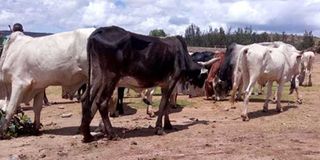We mustn’t slaughter cattle due to drought

Emaciated cows on sale at the Maralal livestock market. PHOTO | FILE| NATION MEDIA GROUP
What you need to know:
- The move by the Agriculture ministry to establish commercial feedlots will definitely bridge the gap.
- Over the past few years, extremely emaciated cattle on the verge of death have been revived and fattened at the few small-scale feedlots in Kenya.
- Last year, Kajiado County lost 232,400 head of cattle (Sh13.9 billion) to drought.
- In 2011 alone, Kenya lost 3.5 million head of cattle, worth Sh52 billion, to drought, and 2.7 million goats and 2.5 million sheep, making it a total of Sh11.7 billion.
A recent government announcement to local investors to express their interest in establishing feedlots in strategic livestock holding grounds is not only an investment opportunity but will save millions of animals that die every year because of drought.
Many a time, the government, humanitarian organisation and even United Nations agencies have worsened the impact of drought by slaughtering emaciated livestock to distribute free meat to communities instead of helping the animals to recuperate so as to produce quality beef and generate an income for the owners.
The move by the Agriculture ministry to establish commercial feedlots will definitely bridge the gap.
A feedlot is an intensive animal feeding programme for finishing livestock — in most cases beef cattle but also swine, sheep, turkeys, chickens or ducks — prior to slaughter. A one-acre beef cattle feedlot can hold up to 450 animals at once.
EMACIATED CATTLE
Over the past few years, extremely emaciated cattle on the verge of death have been revived and fattened at the few small-scale feedlots in Kenya to attain internationally acceptable slaughter weight.
They are fed on intensive protein feed concentrates in flour form made from a mixture of soy beans, sunflower cakes, Lucerne grass, corn and other protein cereals and oil crops. Within 90 days, a dying animal will have put on 200 kilogrammes or even more.
This has worked very well in Botswana, which is nearly 100 per cent semi-arid but is now the only African country that exports beef to Europe.
If Kenya salvaged all those animals, it could produce enough beef for the local and export market.
In 2011 alone, Kenya lost 3.5 million head of cattle, worth Sh52 billion, to drought, and 2.7 million goats and 2.5 million sheep, making it a total of Sh11.7 billion.
FURTHER PROPAGATION
In short, we buried Sh63.7 billion that could have been salvaged through feedlot fattening programmes.
That was the time when hundreds of cattle died at Kenya Meat Commission (KMC) while waiting to be slaughtered.
Last year, Kajiado County lost 232,400 head of cattle (Sh13.9 billion) to drought.
Such losses can easily be prevented through feedlot programmes. Some of the salvaged cattle, especially breeders, can be sold back to the owners for further propagation to sustain the livestock-based economies.
The programmes would also enhance the agricultural value chains by providing a direct market for animal feed raw materials such as hay and fodder, grains and oil crops.
SEMI-ARID AREAS
A recent study by the Kenya Markets Trust in collaboration with the DfID and IDRC showed that cattle population in all semi-arid areas has decreased by 26 per cent in the past 39 years mainly because of changes in climatic conditions.
And with the ever increasing population, there is more pressure on rangelands with people seeking space for settlement and agricultural production.
In Kajiado, 64 per cent of the county is private land, not open for grazing.
Pastoralists will now have an alternative of handing over emaciated animals to feedlots for fattening, earning an income instead of burying carcasses.
Mr Esipisu is a freelance science journalist and the coordinator for Pan-African Media Alliance for Climate Change (Pamacc). [email protected].




